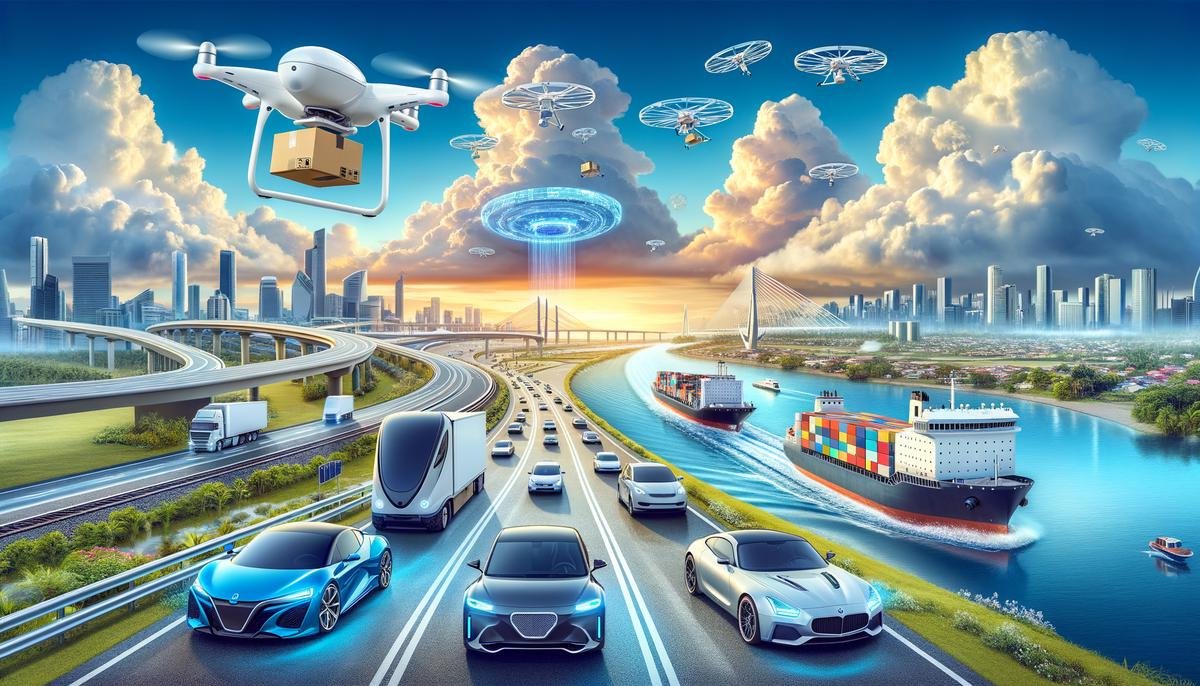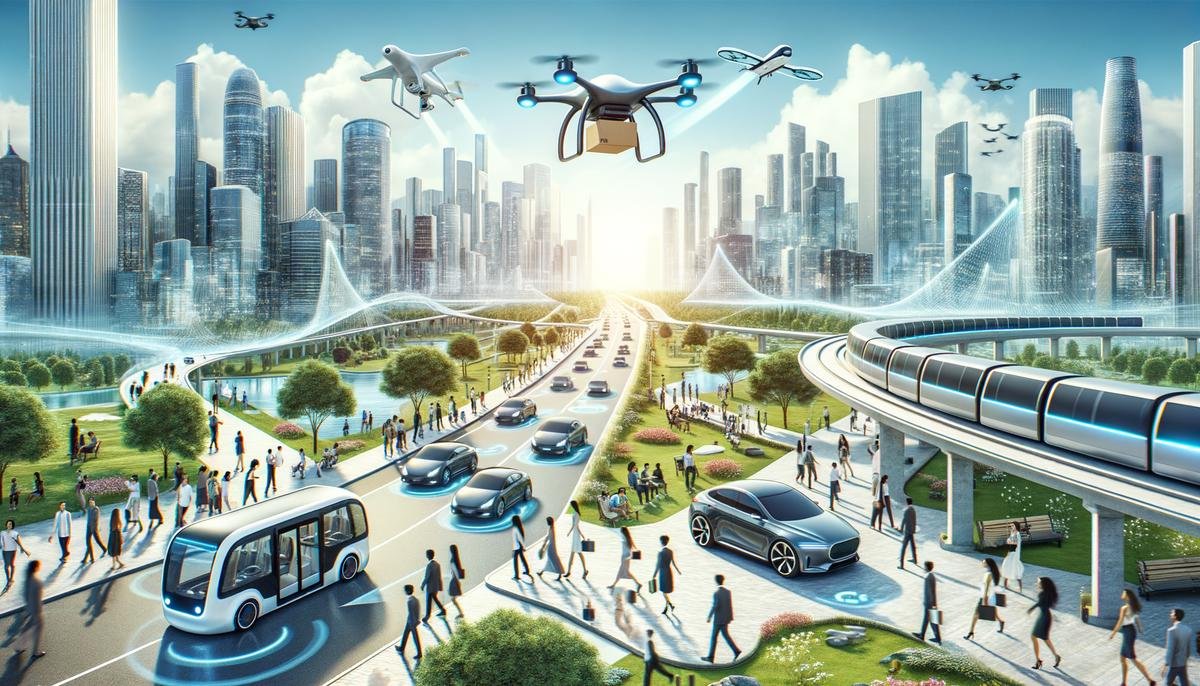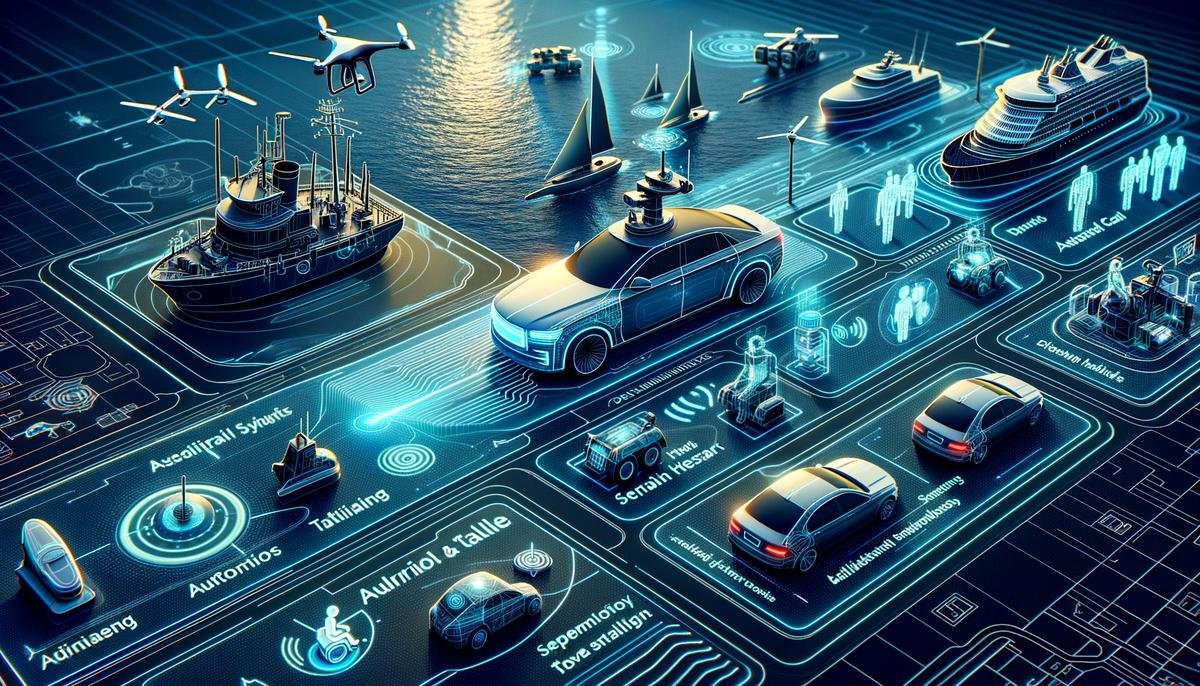Evolution of AI in Transportation
AI Transforms the Transportation Industry: A Comprehensive Look
The transportation industry has undergone significant transformation over recent years, primarily through the integration of Artificial Intelligence (AI). This progressive change has refined everything from how vehicles operate to how traffic is managed, marking a new era in transportation. Let’s delve into the details.
Self-driving Cars: AI’s Frontline Innovators
Perhaps the most talked-about application of AI in transportation is in self-driving, or autonomous, vehicles. Companies like Tesla and Waymo lead the charge, equipping cars with complex AI systems. These systems process vast amounts of data from sensors and cameras to navigate roads, avoid obstacles, and make split-second decisions that would challenge even the most skilled human drivers.
AI’s role doesn’t stop at just keeping the car on the road; it also improves safety. By analyzing data from numerous trips, AI can predict and avoid potential accidents, making self-driving cars increasingly safer than those driven by humans. This major leap could drastically reduce traffic-related fatalities in the future.
Enhanced Traffic Management Systems
Beyond controlling vehicles, AI has reshaped traffic management. Cities around the world are employing AI to analyze traffic patterns and adjust signals accordingly to reduce congestion. These smart traffic management systems can adapt in real-time to changing conditions — an approach far more efficient than static traffic schedules.
For instance, in response to an unexpected road closure or a sudden surge in traffic, AI can reroute vehicles to less congested roads, easing the overall traffic load. This dynamic traffic control not only saves time for commuters but also contributes to lower emissions from idling vehicles.
Revolutionizing Public Transportation
AI’s impact extends to public transit as well. Rail networks and bus services leverage AI to optimize routes, schedules, and operations. By analyzing passenger data, these systems can predict peak travel times, adjust capacities, and even propose new routes to better serve commuters’ needs.
Furthermore, chatbots and AI-driven apps provide passengers with real-time updates and personalize travel recommendations, enhancing the overall user experience. This level of service customization was unimaginable just a decade ago.
Logistics and Supply Chain Efficiency
The logistics sector benefits significantly from AI, especially in route planning and inventory management. AI algorithms calculate the most efficient delivery routes, taking into account factors like traffic, weather, and delivery windows. This optimization leads to faster delivery times, lower operational costs, and a smaller carbon footprint.
In warehouses, AI-powered robots streamline the picking and packing process, reducing errors and improving efficiency. This automation enables companies to meet the ever-growing consumer demand for quick, reliable service.
In conclusion, AI’s integration into the transportation industry is reshaping it from the ground up. From making self-driving cars a reality to optimizing public transport and logistics, AI is not just a technological advancement; it’s a pivotal change agent. As these intelligent systems continue to evolve, we can expect even more innovative solutions to emerge, further transforming transportation’s future landscape.

AI-driven Innovations Beyond Self-Driving Cars
AI-Driven Innovations Paving the Future of Air Travel
The realm of transportation is undergoing a transformative phase with the integration of Artificial Intelligence (AI), far beyond the confines of self-driving cars. Among the myriad innovations, AI-driven advancements in air travel stand out for their potential to revolutionize the way we experience flying.
One of the most significant contributions of AI to air travel is in the domain of predictive maintenance. Utilizing vast pools of data from aircraft sensors and maintenance records, AI algorithms can forecast potential failures and suggest preemptive maintenance actions. This approach not only enhances safety but also significantly reduces downtime and operational costs, ensuring flights remain on schedule more reliably.
Flight operations have also witnessed a paradigm shift with the introduction of AI. Algorithms are now capable of optimizing flight paths in real-time, considering factors such as weather conditions, airspace restrictions, and fuel efficiency. This leads to shorter flight times, reduced fuel consumption, and a decrease in carbon emissions, contributing to more sustainable aviation practices.
Customer service is another area within air travel that has been redefined by AI innovations. Chatbots and virtual assistants, powered by sophisticated AI, are now capable of handling bookings, providing personalized travel updates, and addressing customer queries efficiently, 24/7. This automation not only improves the customer experience but also allows human customer service representatives to focus on more complex issues, streamlining operations.
In the realm of security, AI plays a pivotal role in enhancing airport safety measures. Through the use of advanced AI algorithms, security systems can now analyze video footage in real-time, identifying potential security threats with greater accuracy and speed than ever before. This capability extends to automated facial recognition technology, which can swiftly identify individuals on watch lists, bolstering airport security while minimizing manual checks and reducing queues.
Furthermore, AI is instrumental in revolutionizing baggage handling systems. Equipped with AI and machine learning technologies, these systems can better track luggage, predict and prevent mishandling incidents, and optimize the routing of bags through complex airport conveyor networks. As a result, passengers experience fewer delays and mishaps with their luggage, enhancing overall satisfaction with air travel services.
As we look to the skies, it’s clear that AI-driven innovations are setting a new course for the future of air travel. From predictive maintenance and optimized flight operations to unparalleled customer service and enhanced security measures, AI is not only making air travel more efficient and safer but also more environmentally friendly. As these technologies continue to evolve, the promise of a smoother, more enjoyable air travel experience lies on the horizon, forever changing our relationship with the skies above.

Challenges and Ethical Considerations
As we dive deeper into the realm of AI-driven transportation, numerous challenges and ethical considerations emerge, especially as these technologies become more intertwined with our daily lives. While the innovation in artificial intelligence has unquestionably propelled transportation into new heights of efficiency and safety, it simultaneously opens a Pandora’s box of dilemmas and obstacles that require careful navigation.
Privacy Concerns: The Digital Footprint Dilemma
One of the most pressing challenges is the matter of personal privacy. AI systems, especially in transportation, rely heavily on collecting, processing, and analyzing vast amounts of data to function efficiently. This data often includes sensitive personal information, raising significant privacy concerns. The question then arises: How do we balance the benefits of AI-driven transportation with the fundamental right to privacy? Ensuring robust data protection measures and transparent data usage policies are paramount in addressing these concerns.
Ethical Decision-Making in AI Programming
The ethical programming of AI systems poses another significant challenge. Consider a self-driving car faced with an unavoidable accident scenario. How should the AI decide whom to prioritize – the passengers, pedestrians, or possibly even animals on the road? These ethical dilemmas, often referred to as variations of the “trolley problem,” highlight the complexity of programming AI to make decisions that align with moral and ethical human values. Establishing universally accepted ethical guidelines for AI decision-making is critical in navigating this challenge.
Job Displacement and the Workforce Shift
The rise of AI-driven transportation initiatives also brings about concerns regarding job displacement. Automated systems, by design, can perform tasks traditionally handled by humans, potentially leading to significant shifts in employment within the transportation sector. The ethical consideration of how to manage this transition, support displaced workers, and ensure fair opportunities in the evolving job market is crucial. It’s about finding a balance that leverages AI’s capabilities while also safeguarding the livelihoods of those impacted by technological advancements.
Safety and Security: Navigating Uncharted Territories
Safety concerns, particularly regarding system vulnerabilities and malfunctions, stand at the forefront of AI-driven transportation’s challenges. The reliance on AI systems introduces risks such as hacking and cyber-attacks that could have catastrophic outcomes. Ensuring the highest standards of cybersecurity and developing robust fail-safe measures are critical steps in mitigating these risks.
Similarly, the regulatory landscapes for AI in transportation are still developing. Establishing comprehensive legislation and standards that ensure the safe and ethical deployment of AI technologies is vital. These regulations not only need to address current capabilities but also be adaptable to future advancements and unforeseen challenges.
Addressing Biases: The AI Equity Challenge
Finally, the issue of bias in AI algorithms is a significant concern. AI systems learn from vast datasets, and if these datasets contain biased information, the AI’s decisions and operations could perpetuate and amplify these biases. Ensuring fairness and equity in AI-driven transportation means actively working to identify and eliminate biases within AI algorithms. This includes fostering diversity in the teams developing these technologies, as well as in the data used to train AI systems.
Conclusion
As AI continues to revolutionize transportation, addressing these challenges and ethical considerations is paramount. Striking the right balance between innovation and responsibility, privacy and efficiency, as well as progress and safety requires a concerted effort from developers, policymakers, and society at large. Only then can we fully harness the potential of AI-driven transportation initiatives while mitigating their risks and ensuring they serve the greater good.

Future Prospects and Potential Transformations
In the ongoing evolution of transportation, artificial intelligence (AI) stands out as a transformative force. Beyond self-driving cars and smarter traffic management, AI’s integration into the fabric of transportation suggests a future where travel becomes more efficient, safer, and environmentally friendly. This vision for the future hinges on harnessing AI to overcome current limitations and unlock new possibilities.
One area ripe for AI-driven innovation is infrastructure maintenance. Roads, bridges, and railway systems can benefit from AI technologies that predict when and where repairs are needed, thereby reducing the risk of accidents and minimizing maintenance costs. By analyzing data collected from sensors embedded in infrastructure, AI algorithms can forecast wear and tear, enabling preemptive repairs before issues escalate into costly problems.
Electric vehicle (EV) charging networks represent another frontier for AI in transportation. As the adoption of EVs accelerates, AI can optimize the placement and operation of charging stations, ensuring they meet demand without overburdening the electrical grid. AI can analyze usage patterns, predict peak times, and manage power distribution efficiently, making EV ownership more convenient and sustainable.
Furthermore, AI is set to revolutionize maritime transportation with autonomous ships. These vessels can navigate the oceans more efficiently, reducing fuel consumption and greenhouse gas emissions. AI systems onboard can process real-time data from the environment, weather, and other vessels to plot optimal routes, avoid hazards, and even conduct scientific research during voyages.
In urban environments, drone delivery services are on the cusp of becoming commonplace, thanks to AI. By navigating cityscapes autonomously, drones can deliver goods quickly and reduce the need for road-based delivery vehicles, thereby mitigating traffic congestion and pollution.
The educational sector, too, will see benefits as AI-driven transportation technologies can be used to enhance access to education. For example, autonomous school buses could provide safe and efficient transport for students, especially in underserved areas, making education more accessible.
In all these developments, the role of AI in data analysis cannot be overstated. The vast amounts of data generated by transportation systems – from traffic patterns to vehicle performance metrics – are a goldmine for AI. By sifting through this data, AI can uncover insights that lead to better decision-making, whether it’s planning a new public transport route or improving the aerodynamics of a vehicle.
As we peer into the future, the narrative of transportation is being rewritten by AI. The journey toward this future involves not just technological advancements but also addressing the social, ethical, and environmental implications of these changes. By considering these factors, we can steer AI’s role in transportation toward a path that maximizes benefits for society as a whole. As we move forward, the collaboration between policymakers, technologists, and communities will be crucial in shaping a future where AI-enhanced transportation systems are not just about moving from point A to point B, but about doing so in a way that is smarter, safer, and more inclusive.





